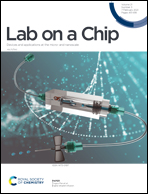The MRD disk: automated minimal residual disease monitoring by highly sensitive centrifugal microfluidic multiplex qPCR†
Abstract
We present a proof-of-principle study on automated, highly sensitive and multiplexed qPCR quantification by centrifugal microfluidics. The MRD disk can be used for standardisation of repetitive, longitudinal assays with high requirements on reproducibility and sensitivity, such as cancer monitoring. In contrast to high-throughput qPCR automation by bulky and expensive robotic workstations we employ a small centrifugal microfluidic instrument, addressing the need of low- to mid-throughput applications. As a potential application we demonstrate automated minimum residual disease (MRD) monitoring of prognostic markers in patients with acute lymphoblastic leukaemia (ALL). The disk-workflow covers all aspects of clinical gold standard MRD quantification: generation of standard curves, specificity controls, no template controls and quantification of the ALL patient sample. We integrated a highly sensitive, colorimetric 2-plex analysis of MRD targets, as well as a 2-plex analysis of reference genes, both in parallel and in a single LabDisk cartridge. For this purpose, a systematic procedure for crosstalk- and signal-to-noise-optimisation is introduced, providing a guideline for efficient multiplex readout inside microfluidic platforms. The qPCR standard curves (n = 12/12) generated on-disk reach clinically required linearity (R2 = 98.1% to R2 = 99.8%). In three consecutive MRD disk runs with an ALL patient sample containing the two representative MRD targets VH3D3D5JH3 and VkIkde, we observe high accordance between the on-disk quantifications (48 ± 6 copies/reaction and 69 ± 6 copies/reaction) and the expected concentrations (57 copies/reaction for both targets). In comparison to the clinical gold standard of manually pipetted, singleplex assays, the MRD disk yields comparable limit of quantification (1 × 10−4) in n = 6/6 analyses (vs. n = 4/4 in gold standard) and a limit of detection (1 × 10−5) in n = 6/6 analysis (vs. n = 2/4 in gold standard). The automation reduces the risk of manual liquid handling errors, making the MRD disk an attractive solution to assure reproducibility in moderate-throughput, longitudinal gene quantification applications.



 Please wait while we load your content...
Please wait while we load your content...